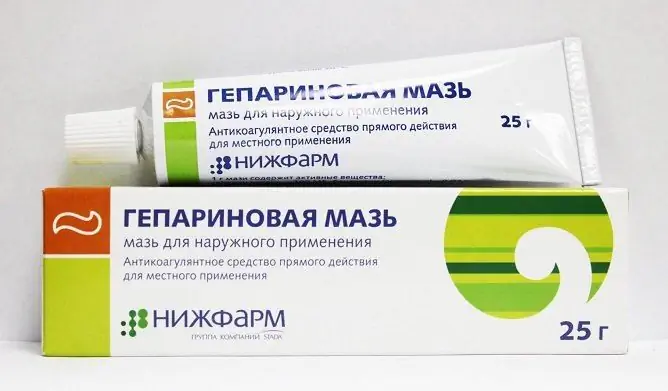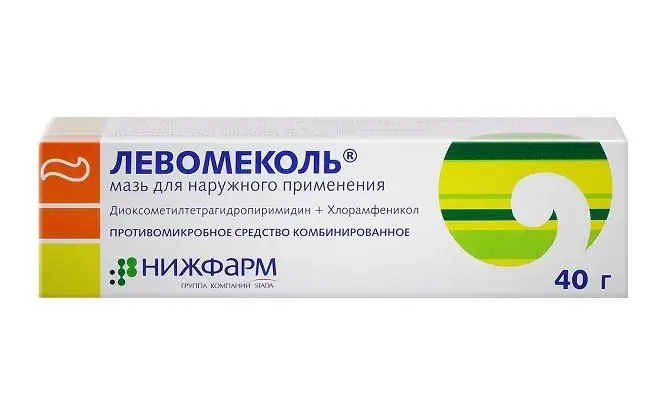- Author Rachel Wainwright [email protected].
- Public 2023-12-15 07:39.
- Last modified 2025-11-02 20:14.
Supirocin
Supirocin: instructions for use and reviews
- 1. Release form and composition
- 2. Pharmacological properties
- 3. Indications for use
- 4. Contraindications
- 5. Method of application and dosage
- 6. Side effects
- 7. Overdose
- 8. Special instructions
- 9. Application during pregnancy and lactation
- 10. Use in childhood
- 11. In case of impaired renal function
- 12. For violations of liver function
- 13. Use in the elderly
- 14. Drug interactions
- 15. Analogs
- 16. Terms and conditions of storage
- 17. Terms of dispensing from pharmacies
- 18. Reviews
- 19. Price in pharmacies
Latin name: Supirocin
ATX code: D06AX09
Active ingredient: Mupirocin (Mupirocin)
Manufacturer: Glenmark Pharmaceuticals Ltd. (India)
Description and photo update: 2018-25-10
Prices in pharmacies: from 453 rubles.
Buy

Supirocin is an antibacterial agent for external use.
Release form and composition
Dosage form - ointment for external use 2%: uniform consistency, white (15 g in aluminum tubes, each tube is placed in a cardboard box).
Composition of 1 g of ointment:
- active substance: mupirocin - 20 mg;
- additional components: macrogol 4000 (polyethylene glycol 4000), macrogol 400 (polyethylene glycol 400).
Pharmacological properties
Pharmacodynamics
Mupirocin - the active ingredient of Supirocin - is an antibiotic produced by the microorganism Pseudomonas fluorescens. The mechanism of its action is due to the ability to suppress protein synthesis of the bacterial cell through reversible binding to isoleucine-transport RNA synthetase, as a result of which the inclusion of isoleucine in the protein chains under construction is prevented.
In minimal concentrations, the drug has a bacteriostatic effect, in higher concentrations it is bactericidal.
Due to its unique chemical structure and specific mechanism of action, mupirocin does not cross-resistance with other antibiotics.
With the correct use of the drug, there is practically no risk of the appearance of resistant strains of microorganisms.
In vitro, mupirocin is active against the following bacteria:
- gram-positive aerobes: Staphylococcus species, Staphylococcus epidermidis, coagulase-negative Staphylococcus, Staphylococcus aureus (including strains producing beta-lactamases and resistant to methicillin);
- gram-negative anaerobes: Branhamella catarrhalis, Neisseria meningitidis, Pasteurella multocida, Neisseria gonorrhoeae, Proteus mirabilis, Citrobacter freundii, Enterobacter aerogenes, Bordetella pertussis, Proteus vulgaris, Haemophilus influenterzae, Enter.
Gram-negative non-fermenting bacilli, Corynebacterium species, Micrococcus, Enterobacteriaceae are insensitive to the action of mupirocin.
Pharmacokinetics
When applied externally, in the absence of damage to the skin, mupirocin is practically not absorbed.
In the presence of lesions on the skin, the drug is absorbed, after which it is metabolized to a microbiologically inactive metabolite (monic acid) and rapidly excreted by the kidneys.
Indications for use
Supirocin is used to treat primary and secondary infections of the skin caused by microorganisms sensitive to its action, including the following diseases:
- primary infections: folliculitis, ecthyma, impetigo, furunculosis (including furuncles of the external auditory canal and auricle);
- secondary infections: infected trauma (wounds, abrasions, burns, insect bites), infected eczema.
Contraindications
- children under 3 years old;
- hypersensitivity to the drug.
Supirocin should not be used on large areas of the body in conditions in which increased absorption of macrogol (an excipient of the ointment) is possible, especially in moderate to severe renal failure.
Instructions for the use of Supirocin: method and dosage
Supirocin is used externally. A small amount of ointment should be applied to the affected area 2-3 times a day. If necessary, a bandage can be applied over the top.
The duration of treatment depends on the severity of the disease and is no more than 10 days.
If there is no clinical effect within 3-5 days of therapy, you should consult a doctor to revise the diagnosis and treatment regimen.
Side effects
Supirocin ointment is well tolerated.
Very rarely, itching and burning occur at the site of application of the drug. Less than 1% of patients have contact dermatitis, edema, dry skin, erythema.
Allergic skin reactions (rash, swelling at the site of application) are rare. In isolated cases, generalized allergic reactions are possible.
Overdose
Considering the topical application of the ointment and its low absorption in the absence of skin lesions, an overdose of mupirocin is unlikely.
special instructions
Supirocin ointment should not be applied to mucous membranes and in the area of drainage. Avoid contact with eyes. If this happens, it is recommended that you rinse your eyes thoroughly with water.
After applying the drug to the skin, wash your hands well.
In rare cases of development of significant skin irritation or allergic reactions, you should stop using Supirocin, rinse the affected area with water and consult a doctor for alternative antibiotic therapy.
With prolonged use of mupirocin, like other antibiotics, excessive growth of insensitive microorganisms is possible.
Influence on the ability to drive vehicles and complex mechanisms
The components of the drug do not adversely affect the speed of a person's reactions and his ability to concentrate.
Application during pregnancy and lactation
There is insufficient data on the safety of the use of mupirocin during pregnancy, therefore, Supirocin is prescribed only in cases where the expected benefits outweigh the potential risks.
Given the external route of administration of the drug, excretion of mupirocin in breast milk is unlikely. Nevertheless, supirocin is prescribed for lactating women after assessing the balance of benefits and risks.
Pediatric use
According to the instructions, Supirocin is contraindicated in children under 3 years of age.
With impaired renal function
In case of renal failure, the drug should be used with caution.
In moderate to severe renal failure, do not apply the ointment to large areas of the skin.
For violations of liver function
No dose adjustment is required.
Use in the elderly
There are no restrictions on the use of Supirocin in old age.
Drug interactions
There were no cases of interaction of Supirocin with other drugs.
The ointment should not be combined with other topical preparations, since it may decrease its antibacterial effect and loss of stability.
Analogs
Analogs of Supirocin are Bactroban and Bonderm ointments.
Terms and conditions of storage
The shelf life is no more than 2 years.
Storage conditions: dry, dark place, out of reach of children, temperature up to 25 ° C. Avoid freezing.
Terms of dispensing from pharmacies
Dispensed by prescription.
Reviews of Supirocin
According to reviews, Supirocin is an effective antibacterial agent that quickly helps in dermatological diseases caused by microorganisms sensitive to mupirocin.
Price for Supirocin in pharmacies
The price of Supirocin for 1 tube with a volume of 15 g varies between 445-535 rubles.
Supirocin: prices in online pharmacies
|
Drug name Price Pharmacy |
|
Supirocin 2% ointment for local and external use 15 g 1 pc. 453 r Buy |
|
Supirocin ointment 2% 15g 468 r Buy |

Maria Kulkes Medical journalist About the author
Education: First Moscow State Medical University named after I. M. Sechenov, specialty "General Medicine".
Information about the drug is generalized, provided for informational purposes only and does not replace the official instructions. Self-medication is hazardous to health!






